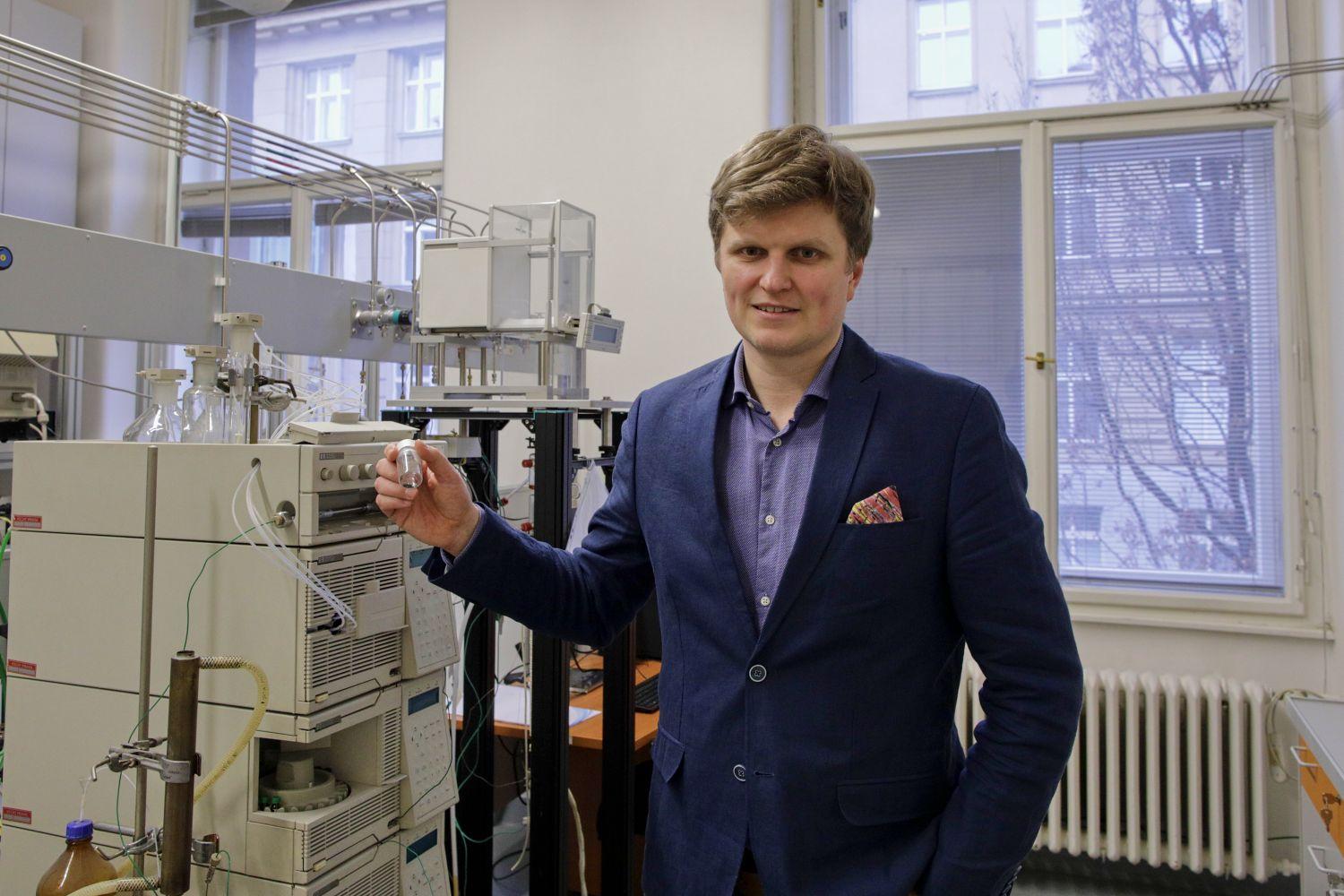
Beyond graphene: research in 2D materials continues
Martin Veselý (MSc., PhD) succeeded receiving the Czech Science Foundation’s JUNIOR STAR 2023 grant for his project entitled Synthesis and Property Tuning of Layered Low-Dimensional Materials Beyond Graphene – Utilization in Fundamental Research of Heterogeneous Catalysts. The project leverages his prior experiences and training both at various UCT Prague departments and the Czech Academy of Science’s Institute of Chemical Process Fundamentals as well as a two-year stay in the Netherlands.
Congratulations on this terrific success!
Thank you. But it’s not just my success; it’s the success of all the colleagues who performed various preliminary measurements with me. I also could not have succeeded without the support and friendly, stimulating environment at UCT Prague and at home.
I heard that you submitted the project proposal twice, is this true?
Yes. In fact, I even used the content three times. This successful grant proposal was based on my JUNIOR STAR attempt in 2021. Although the proposal received an excellent evaluation, it was not financed. That is why I decided to submit it for the third time, including also an unsuccessful European Research Council Starting Grant attempt incorporating the elements of FAIR scientific data principles and the research team management guidelines.
How will JUNIOR STAR affect your life?
I hope minimally (laughing). But seriously, this grant will allow me to significantly expand my (up to now) small team. This means that I will have to delegate more responsibilities to my colleagues and rely on their abilities and skills. I hope that the project will enable me to figure out how new 2D materials could be used in the field of heterogeneous catalysis.
How did you come up with such an interdisciplinary topic?
The idea evolved as a result of my various experiences and the skills that I acquired during my scientific career, which has been relatively varied. At the beginning of my career, I received excellent laboratory training in Prof. Svoboda’s laboratory at UCT Prague’s Department of Organic Chemistry. For my Master studies, I transferred to the Czech Academy of Science’s Institute of Chemical Process Fundamentals, where—under the guidance of MSc. Jiřičný and Prof. Hanika—I gained insight into the technological aspects of chemical reactions, gaining my first experiences with heterogeneous catalysis and learning about the importance of various calculation methods. I returned to UCT Prague, this time the Department of Organic Technology, for my doctoral studies. Under the guidance of Associate Professor Čapek, who was very devoted to supporting me, I learned above all to look critically at my experiments and simulation calculations. During my doctoral studies, I also learned many microscopic and spectroscopic techniques that I used in the study of working catalysts during my two-year postdoctoral fellowship at Utrecht University in Prof. Weckhuysen’s group. After my return, I started teaching Catalysis and Technical Catalysis courses at UCT Prague and concurrently started collaborating with Professor Sofer on the topic of 2D materials that have a well-accessible surface, meaning places where catalysed reactions take place. Such surfaces can be directly analysed with surface and microscopic techniques. Compared to conventional porous catalysts, where a significant portion of the surface is hidden in the internal porous system, accessibly surfaces could be investigated.
Why do you say “beyond graphene” in the title of your proposal?
Graphene is the benchmark for 2D materials that launched a revolution in materials science. However, research in the 2D area does not end with graphene. Possibilities for new 2D materials include silicon and germanium, which, unlike graphene, are significantly easier to modify. This means that their properties, such as charge transfer or conductivity, can be “tailored” to required applications. For this project, it follows that we can fine-tune the properties of the 2D supports themselves and monitor the effect of such modifications on the catalytic activity we will observe.
What is the goal of your project?
The main goal of the project is to measure, understand, and describe the effect of the aforementioned modifications of a 2D support on catalytic activity. To this end, we will try new approaches for the preparation of metal nanoparticles on the surface of a 2D support using lithographic methods. We will test a series of model heterogeneously catalysed reactions on these specially prepared materials. Our goal is to monitor what happens to a catalyst created in this way when it is working—i.e. how morphology, structure, and even catalytic activity—change over time. For monitoring this, we will use correlative spectro-microscopy approaches, which means that we will try to get the maximum possible information from same place of one material.
Which tracking methods will you use?
To characterize structure, morphology, or composition, we will use standard techniques such as SEM, TEM, AFM, Raman spectroscopy, and others and non-standard super-resolution fluorescence microscopy. Thanks to the latter, we can monitor individual reaction turnovers at a specific place of the material. We will not determine how the reactants disappear from a reaction mixture, but we will monitor each individual reaction turnover on the surface of a catalyst. Here again, the great advantage of a 2D material is that the surface is not “hidden” somewhere in the pores, but it is relatively easily visible for this method. Thanks to this, it is possible to obtain spatially and temporally resolved catalytic activity measures and thus find out how a 2D support participates in this activity and whether a support conveys any information between individual active centres. If we succeed in confirming our hypothesis, this would be a major success of the project, which could lead to new approaches in the design of heterogeneous catalysts. Proving communication conveyance will be very demanding, which is why we also have a backup, more realistic project goal. Materials based on silicon and germanium can also be synthesized in the form of quantum dots. These can be used to display the diffusivity in the porous system of conventional catalysts. The quantum dot method is not new, but the dots currently used are based on heavy metals like cadmium that we can never get back from the material. Replacing such quantum dots with environmentally-friendly ones would make this type of analysis more attractive.
Will you have separate teams for different kinds of research activities?
The teams will be linked, but they will not be tied to one particular department. The core of the team is comprised of colleagues from UCT Prague’s Department of Organic Technology, but researchers from the Department of Inorganic Chemistry and the Department of Biochemistry and Microbiology will participate as well. I also established cooperation with ETH Zurich, where we will try not only to observe the activity of the prepared catalysts, i.e. how many reaction turnovers we are able to detect per unit of time, but—thanks to their Tip-Enhanced Raman Spectroscopy (TERS) system—we will also able to determine the selectivity of these reaction turns.
Do you have enough space for everyone?
I don’t have enough space. For now, we are using my colleagues’ existing premises. They are accommodating to me and willing to share space with me. I hope that in the near future we will have both office and laboratory space available.
What would you suggest to other grant applicants?
I would advise everyone to do two things. First, persevere and do not cease your efforts in getting your own funding after your first failure. Second, I would suggest keeping an open mind and collecting stimuli from your wider environment with the aim of creating at least a partially multidisciplinary project. Young researchers should not close themselves into the bubbles of their field and workplace. Had I written the proposal only to prepare new materials, I probably would not have received funding. I believe that I managed to convince the grant competition evaluators because I connected my diverse experiences with my desire to understand the connection between how things look and how they work.







